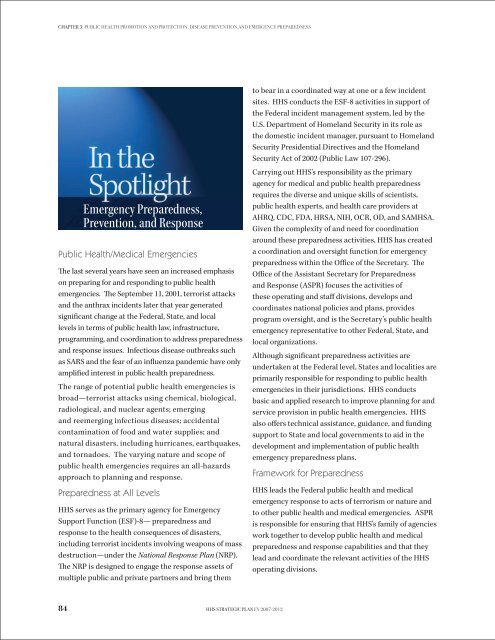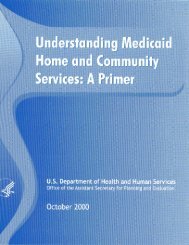STRATEGIC PLAN - ASPE - U.S. Department of Health and Human ...
STRATEGIC PLAN - ASPE - U.S. Department of Health and Human ...
STRATEGIC PLAN - ASPE - U.S. Department of Health and Human ...
You also want an ePaper? Increase the reach of your titles
YUMPU automatically turns print PDFs into web optimized ePapers that Google loves.
CHAPTER 3: Public <strong>Health</strong> Promotion <strong>and</strong> Protection, Disease Prevention,<strong>and</strong> Emergency PreparednessEmergency Preparedness,Prevention, <strong>and</strong> ResponsePublic <strong>Health</strong>/Medical EmergenciesThe last several years have seen an increased emphasison preparing for <strong>and</strong> responding to public healthemergencies. The September 11, 2001, terrorist attacks<strong>and</strong> the anthrax incidents later that year generatedsignificant change at the Federal, State, <strong>and</strong> locallevels in terms <strong>of</strong> public health law, infrastructure,programming, <strong>and</strong> coordination to address preparedness<strong>and</strong> response issues. Infectious disease outbreaks suchas SARS <strong>and</strong> the fear <strong>of</strong> an influenza p<strong>and</strong>emic have onlyamplified interest in public health preparedness.The range <strong>of</strong> potential public health emergencies isbroad—terrorist attacks using chemical, biological,radiological, <strong>and</strong> nuclear agents; emerging<strong>and</strong> reemerging infectious diseases; accidentalcontamination <strong>of</strong> food <strong>and</strong> water supplies; <strong>and</strong>natural disasters, including hurricanes, earthquakes,<strong>and</strong> tornadoes. The varying nature <strong>and</strong> scope <strong>of</strong>public health emergencies requires an all-hazardsapproach to planning <strong>and</strong> response.Preparedness at All LevelsHHS serves as the primary agency for EmergencySupport Function (ESF)-8— preparedness <strong>and</strong>response to the health consequences <strong>of</strong> disasters,including terrorist incidents involving weapons <strong>of</strong> massdestruction—under the National Response Plan (NRP).The NRP is designed to engage the response assets <strong>of</strong>multiple public <strong>and</strong> private partners <strong>and</strong> bring themto bear in a coordinated way at one or a few incidentsites. HHS conducts the ESF-8 activities in support <strong>of</strong>the Federal incident management system, led by theU.S. <strong>Department</strong> <strong>of</strong> Homel<strong>and</strong> Security in its role asthe domestic incident manager, pursuant to Homel<strong>and</strong>Security Presidential Directives <strong>and</strong> the Homel<strong>and</strong>Security Act <strong>of</strong> 2002 (Public Law 107-296).Carrying out HHS’s responsibility as the primaryagency for medical <strong>and</strong> public health preparednessrequires the diverse <strong>and</strong> unique skills <strong>of</strong> scientists,public health experts, <strong>and</strong> health care providers atAHRQ, CDC, FDA, HRSA, NIH, OCR, OD, <strong>and</strong> SAMHSA.Given the complexity <strong>of</strong> <strong>and</strong> need for coordinationaround these preparedness activities, HHS has createda coordination <strong>and</strong> oversight function for emergencypreparedness within the Office <strong>of</strong> the Secretary. TheOffice <strong>of</strong> the Assistant Secretary for Preparedness<strong>and</strong> Response (ASPR) focuses the activities <strong>of</strong>these operating <strong>and</strong> staff divisions, develops <strong>and</strong>coordinates national policies <strong>and</strong> plans, providesprogram oversight, <strong>and</strong> is the Secretary’s public healthemergency representative to other Federal, State, <strong>and</strong>local organizations.Although significant preparedness activities areundertaken at the Federal level, States <strong>and</strong> localities areprimarily responsible for responding to public healthemergencies in their jurisdictions. HHS conductsbasic <strong>and</strong> applied research to improve planning for <strong>and</strong>service provision in public health emergencies. HHSalso <strong>of</strong>fers technical assistance, guidance, <strong>and</strong> fundingsupport to State <strong>and</strong> local governments to aid in thedevelopment <strong>and</strong> implementation <strong>of</strong> public healthemergency preparedness plans.Framework for PreparednessHHS leads the Federal public health <strong>and</strong> medicalemergency response to acts <strong>of</strong> terrorism or nature <strong>and</strong>to other public health <strong>and</strong> medical emergencies. ASPRis responsible for ensuring that HHS’s family <strong>of</strong> agencieswork together to develop public health <strong>and</strong> medicalpreparedness <strong>and</strong> response capabilities <strong>and</strong> that theylead <strong>and</strong> coordinate the relevant activities <strong>of</strong> the HHSoperating divisions.84 HHS Strategic Plan FY 2007-2012
















